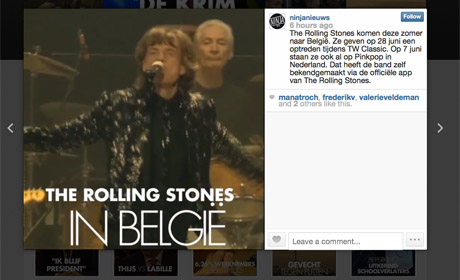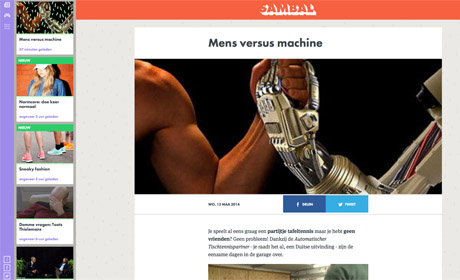
It is nut that many news outlets are trying to crack: how to engage with a younger audience more often finding their news based on what their friends are sharing on social media platforms.
Last year, Belgium-based public service broadcaster VRT set up an internal 'Start-up', a team tasked with engaging the "YouTube generation" – with a focus on roughly 16 to 24 year-olds – and experimenting with new platforms and different ways to tell stories.
Many news outlets have established internal incubators or news labs to help drive innovative thinking, and the hope is that VRT's version will help the broadcaster re-engage with this audience in particular.
"We didn't reach young people any more with our classic radio and TV," member of Start-up Lesley Demuynck told Journalism.co.uk. "In the digital world, people could go onto YouTube and Facebook and the big players in the world, and we as a regional media outlet were losing grip on that generation."
Their work has been guided directly by the target audience via 'Insight Sessions' held fortnightly across the country, as well as feedback gathered via their own digital channels.
The Insight Sessions, which bring together individuals from the target age-group, have served to highlight not only the prevalence of networks such as Facebook and Snapchat in that generation's media diet, but also the specific ways in which they are being used.
Three key projects have been pursued by the team in beta following its launch, two of which are editorially-focused, and driven by social media: a mobile video project called Ninjanieuws, which exists on Instagram and Snapchat, and a Facebook-supported news platform called Sambal. The third project, called OpenVRT, is a collaboration project to bring together young people with key digital skills such as in blogging, video and photography, with VRT.
The team are in the final weeks of testing and tweaking the projects before they, or at least the thinking and findings behind them, will be incorporated in some way within VRT itself.
- Building short-form video ninjas

The need to keep any video product very short was something the team identified early on. "We knew already that young people didn't watch video that much," Demuynck said. "If they are on YouTube for instance, even a 30 second clip is quite long for them."
Even when embedding YouTube videos into articles elsewhere, for example, the team found the target audiences responded much better to clips of that video turned into animated gifs, with links to the complete piece on YouTube.
And so the first platform it chose to launch its Ninjaneuws product was Instagram. A number of other news outlets are also trying different models on the platform for both the creation and sharing of images and its 15-second video feature, from interview snapshots, behind-the-scenes images and daily news round-ups.
Inspired by NowThis News's use of the Instagram platform, and supported by the fact the team would have access to the existing video output of the broadcaster, the Start-up team decided to focus on the 15-second videos when launching Ninjanieuws.
Each 'Ninja' video tells a single story, using images, audio and text, with a two hour production time per video. And the editorial focus of them is news, following the agenda and reporting of the news site "to make it go faster".
Shifting onto Snapchat

While it started on Instagram, the team decided to also bring Ninjanieuws to Snapchat community, with "two versions" of each Ninja created in order to ensure it will work on each platform, with the Snapchat iPhone app limiting videos to 10 seconds.
The team's approach was to create the Instagram Ninja first, and then try and create a shorter version for Snapchat. But it is "very hard to have a news item in 10 seconds", Demuynck added. "I'm now struggling with how much can you say in as little as possible."
"We want it to be a story, even if it's only 10 seconds. So that's something I'm working on now ".
Picking up the pace
With a need for speed, and to make it possible to grow the operation in the future, the Start-up team is also creating a Ninja-maker to make it possible for those without video editing skills to create a Ninja using images, text and audio.
"Once we have that, that means we can really go professional and also quicker," Demuynck said. "[You] can't have breaking news if it takes you two hours to make a Ninja".
For now, however, the Ninjas are focused on stories which do not relate to ongoing events where information could change or need to be updated, he explained.
But they are considering opportunities to experiment with other "domains", such as sport , culture and even weather, he said, and the ability to perhaps apply a list format to the content, such as a top ten.
"These are all things that we're testing out."
And on reflection, Demuynck feels the Snapchat audience may even be better aligned to the sort of demographic the team is looking for after all, and has the potential to become a platform that will, in time, be used by publishers in the same way a text alert is currently.
He added that the Instagram audience tends to be a "bit older than the real YouTube generation, but still it's something valuable and something that we try to explore".
"So we maintain it," he added, "but I think if we had known earlier about the success of Snapchat we may have tried it directly on there".
- Sambal

When it comes to social media, news outlets are trying to be active on as many platforms as possible, and ensure they are not only pushing content out but also using them to engage in two-way conversations with their communities.
But for the 16 to 24 age group "Facebook's still King", Demuynck said.
"We learned that we shouldn't focus on Twitter, we should really focus on Facebook," Demuynck said, dismissing suggestions of "Facebook fatigue". "Facebook wasn't faded, and very popular still".Facebook's still King in that age groupLesley Demuynck, VRT Start-up
And while much of this engagement occurred within private groups, the popularity of the platform meant "the things we did had to be on Facebook," he added.
This is why, when the team launched Sambal, they looked to Facebook as the key social media destination to help push engagement around the content.
The evolution of the model
The current model for the site has evolved over time, following two less successful approaches which centred on offering six key stories of the day, delivered at 5pm. Instead, the model that can be seen today, aims to be more "comparable to Vice" in terms of the editorial approach, and offers updates throughout the day.
And a key part of the strategy has been the way it uses Facebook to publish this content more widely, and directly with users of the social network.
In some cases, articles are only published to Sambal's Facebook page, particularly shorter pieces of content, and bypass the Sambal news site altogether.
This project has taught the Start-up team that "we no longer need a real homepage," Demuynck said, with the audience instead using "Facebook as their main stream of everything that's happening".
"If they click on a link in their Facebook screen they don't care where it's at, and they do not go to a homepage."
This also influenced the design of the Sambal site, which features just a narrow stream of stories on the left-hand side, with the remaining space used to display a single article at a time.
And the finding was that this "was sufficient", he said.
Pop-up Facebook pages
While not one of VRT Start-up's main projects, their experiments with Facebook also unlocked the power of using Facebook pages to quickly create and execute effectively standalone digital news products, in response to certain trends.
One example was a page the team created in response to students being distracted by social media. The page – which was run by a specially-recruited member of staff for a month – had the overall aim of snapping students' attention back to their studies.
"What we did was make one meme, one joke and then the bottom line was always 'now get back to work'," he said. "That was an instant success", with the page receiving 20,000 likes "in about a week". The trick is to keep such pages "very thematic", Demuynck said.
"This was never seen before here at VRT, so what we learnt from that is it is possible, if you have a good subject and it's a good line and you create content especially for that."
Free daily newsletter
If you like our news and feature articles, you can sign up to receive our free daily (Mon-Fri) email newsletter (mobile friendly).
Related articles
- Rachel Duffy, senior social media editor of The Telegraph, on using Reddit for news
- 10 creative ways to interview celebrities and experts
- LinkedIn newsletters: are they what they are cracked up to be?
- Fact-based journalism is under attack. What can we do about it?
- What can LinkedIn do for journalists?









